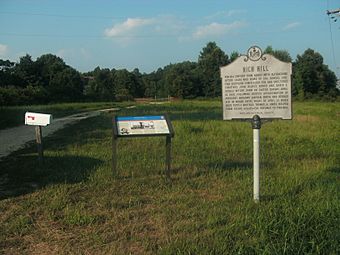Rich Hill (Bel Alton, Maryland) facts for kids
Quick facts for kids |
|
|
Rich Hill
|
|
 |
|
| Location | Northeast of Bel Alton on Bel Alton-Newtown Rd., Bel Alton, Maryland |
|---|---|
| Area | 15 acres (6.1 ha) |
| Built | 1825 |
| NRHP reference No. | 75000885 |
| Added to NRHP | November 12, 1975 |
Rich Hill is a historic home located near Bel Alton, Maryland. It was once owned by Colonel Samuel Cox. He was a supporter of the Confederate side during the American Civil War.
This house became famous because of an event that happened after the war. In 1865, Colonel Cox helped hide John Wilkes Booth. Booth was involved in the death of President Abraham Lincoln. Booth and his friend, David Herold, hid in a swamp near Rich Hill. They stayed there for a few days before leaving on April 21, 1865. They crossed the Potomac River in a small boat.
Contents
Rich Hill's Place in History
Rich Hill is known for its connection to a major event in American history. After the Civil War ended, President Abraham Lincoln was killed. The person responsible, John Wilkes Booth, needed a place to hide. Colonel Samuel Cox allowed Booth and his friend David Herold to hide on his property. They stayed hidden in a swampy area near the house.
What Happened to Colonel Cox?
After John Wilkes Booth was found, Colonel Cox faced consequences for helping him. He was held responsible for his actions. However, he did not receive a very harsh punishment. This part of the story shows how people were affected by the events of the Civil War.
The Rich Hill House
Beyond its historical story, the Rich Hill house is important on its own. It was built in 1825. The house shows many typical features of homes built in southern Maryland during that time. It gives us a look at how houses were designed and constructed long ago.
A Recognized Landmark
Rich Hill was officially recognized for its historical importance in 1975. It was added to the National Register of Historic Places. This list includes buildings, sites, and objects that are important in American history, architecture, archaeology, engineering, and culture. Being on this list helps protect and preserve the site for future generations.



